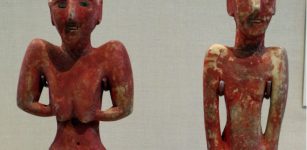Pants And Boots Were Forbidden In Ancient Rome – Trousers Were A Symbol Of Barbarism To Ancient Romans
Conny Waters - AncientPages.com - If you lived in ancient Rome, you would think twice before putting on your pants.
To ancient Romans, trousers were the ultimate symbol of barbarism, and no honorable man wanted to be considered the garb of a savage barbarian.
Credit: Costumes of All Nations (1882) by Albert Kretschmer - Public Domain
There was even a law that strictly prohibited wearing pants and boots in ancient Rome.
Pants and boots (called in Latin 'bracae') were associated with horse-riding barbarians, including many Germanic groups such as Goths, Huns, Vikings, and others.
The term "Barbarians" is today significantly misused. The original meaning of the word "barbarian" did not refer to acts of evil but rather to those who were not Greek or did not speak Greek. In modern times we often say Barbarians are uncivilized people or evil people.
When Ovid, a Roman poet who lived during Augustus's reign, encountered barbarians in today's Tomis, Romania, he wrote:
"The people, even when they were not dangerous, were odious, clothed in skins and trousers with only their faces visible."
One law from 397 and another dated to 399 CE strictly regulated wearing pants and boots in Rome.
Within the city of Rome, no one shall wear pants or boots. But if any man after the issuance of this regulation of Our Clemency should obstinately persist in such contumacy, he shall be punished accordingly as his legal status permits and expelled from our sacred city (Codex Theodosianus, 14.10.3 (June 6, 399 CE)
Gaulish chief Vercingetorix, wearing trousers, surrenders to Julius Caesar after the battle of Alesia in 52 B.C. Painting by Lionel Royer (1852–1926) - Credit: Public Domain
According to Susanne Elm, a historian from the University of California, Berkeley, who studies Rome's relationship with the tribes to the north, "barbarian influence on fashion was something that emperors wanted to control, but then their bodyguards, which presumably they trusted, were barbarians."
The ban on trousers and boots was a desperate attempt to keep the Roman identity alive. During this period, the Empire had become a melting pot of traditions after hundreds of years of expansion and cultural appropriation. Long hair and flashy jewels soon joined boots and pants as forbidden fashion.
"By the fifth and sixth centuries, suddenly the so-called barbarian custom, sleeved top, and trousers had become the official uniform of the Roman court. If you were close to the emperor, that's what you would wear." Professor Kelly Olson, the author of "Masculinity and Dress in Roman Antiquity," said. "Scholars have not yet been able to explain how that happened, trousers going from being banned from being legally required clothes for the Roman court."
It could be explained by the fact that ancient Romans, who were totally against trousers and boots, changed their attitude when Roman soldiers marched into cold Northern Europe and realized the benefits of wearing warm clothes and shoes.
Written by Conny Waters – AncientPages.com Staff Writer
Updated on October 29, 2022
Copyright © AncientPages.com All rights reserved. This material may not be published, broadcast, rewritten or redistributed in whole or part without the express written permission of AncientPages.com
Expand for references
More From Ancient Pages
-
 Bizarre Event – Why Did Hundreds Of Individuals Suddenly Freak Out At A Cemetery?
Featured Stories | May 30, 2023
Bizarre Event – Why Did Hundreds Of Individuals Suddenly Freak Out At A Cemetery?
Featured Stories | May 30, 2023 -
 Secret Behind Ancient Durable Maya Plaster Discovered
Archaeology | Apr 21, 2023
Secret Behind Ancient Durable Maya Plaster Discovered
Archaeology | Apr 21, 2023 -
 What Caused The Unexplained Change In Europeans’ DNA 4000-5000 Years Ago? Scientists Say The Genetic Turnover Remains A Mystery
Archaeology | Aug 27, 2014
What Caused The Unexplained Change In Europeans’ DNA 4000-5000 Years Ago? Scientists Say The Genetic Turnover Remains A Mystery
Archaeology | Aug 27, 2014 -
 New Discoveries Regarding Gladiatorial Games In Roman City Of Carnuntum
Archaeology | Apr 7, 2017
New Discoveries Regarding Gladiatorial Games In Roman City Of Carnuntum
Archaeology | Apr 7, 2017 -
 European Neolithic Family Trees Shed Light On Social Organization
Archaeology | Jul 27, 2023
European Neolithic Family Trees Shed Light On Social Organization
Archaeology | Jul 27, 2023 -
 Ruins Of Roman Temple From Reign Of Emperor Antonius Pius Unearthed In Egypt
Archaeology | May 15, 2018
Ruins Of Roman Temple From Reign Of Emperor Antonius Pius Unearthed In Egypt
Archaeology | May 15, 2018 -
 Male-Female Roles 7,000 Years Ago Were Less Traditional Than Previously Thought – New Study Reveals
Archaeology | Jun 30, 2022
Male-Female Roles 7,000 Years Ago Were Less Traditional Than Previously Thought – New Study Reveals
Archaeology | Jun 30, 2022 -
 Homo Bodoensis Is A New Species Of Human Ancestors Who Lived Half A Million Years Ago
Archaeology | Nov 1, 2021
Homo Bodoensis Is A New Species Of Human Ancestors Who Lived Half A Million Years Ago
Archaeology | Nov 1, 2021 -
 Oldest Greek Oracle At Dodona And Zeus Sacred Oak Tree – Where Oracle of Dodona: Sacred Place Where Gods Spoke To Humans For The First Time
Featured Stories | May 24, 2016
Oldest Greek Oracle At Dodona And Zeus Sacred Oak Tree – Where Oracle of Dodona: Sacred Place Where Gods Spoke To Humans For The First Time
Featured Stories | May 24, 2016 -
 Mystery Of The Coso Artifact: A Spark Plug Or A Genuine Example Of Advanced Antediluvian Technology?
Ancient Technology | Sep 9, 2014
Mystery Of The Coso Artifact: A Spark Plug Or A Genuine Example Of Advanced Antediluvian Technology?
Ancient Technology | Sep 9, 2014 -
 Massagetae Tribe And Its Queen Tomyris Whose Victory Over Cyrus The Great Became A Legend
Civilizations | Nov 18, 2019
Massagetae Tribe And Its Queen Tomyris Whose Victory Over Cyrus The Great Became A Legend
Civilizations | Nov 18, 2019 -
 Archaeologists Make An Unusual Find In A 2,000-Year-Old Romanian Burial Mound
Archaeology | Jul 12, 2023
Archaeologists Make An Unusual Find In A 2,000-Year-Old Romanian Burial Mound
Archaeology | Jul 12, 2023 -
 Bizarre Meat-Eating Dinosaur Found In Classic Fossil Site In Egypt’s Sahara Desert
Archaeology | Jun 9, 2022
Bizarre Meat-Eating Dinosaur Found In Classic Fossil Site In Egypt’s Sahara Desert
Archaeology | Jun 9, 2022 -
 Giant Bath Tub Built For Tsar Alexander I – Why Was It So Large?
Featured Stories | Jul 11, 2018
Giant Bath Tub Built For Tsar Alexander I – Why Was It So Large?
Featured Stories | Jul 11, 2018 -
 Archaeologists Discover Long-Lost Scottish Monastery Of Deer And Solve An Old Manuscript Mystery
Archaeology | Nov 21, 2023
Archaeologists Discover Long-Lost Scottish Monastery Of Deer And Solve An Old Manuscript Mystery
Archaeology | Nov 21, 2023 -
 European Dogs Doubled In Size From 8,000 To 2,000 Years Ago – New Study Shows
Archaeology | Jun 3, 2022
European Dogs Doubled In Size From 8,000 To 2,000 Years Ago – New Study Shows
Archaeology | Jun 3, 2022 -
 Why Was Alexander A Great Military Genius?
Ancient History Facts | Oct 23, 2018
Why Was Alexander A Great Military Genius?
Ancient History Facts | Oct 23, 2018 -
 Gigantic Karnak Temple Complex: Advanced Ancient Technology In Egypt
Civilizations | Apr 6, 2017
Gigantic Karnak Temple Complex: Advanced Ancient Technology In Egypt
Civilizations | Apr 6, 2017 -
 Viking Longships: Fearless Dragonships Daring The Oceans And Seas
Ancient History Facts | Apr 16, 2016
Viking Longships: Fearless Dragonships Daring The Oceans And Seas
Ancient History Facts | Apr 16, 2016 -
 Mysterious Lost Civilization Of Chu And Its Powerful Kingdom
Civilizations | Nov 29, 2018
Mysterious Lost Civilization Of Chu And Its Powerful Kingdom
Civilizations | Nov 29, 2018


